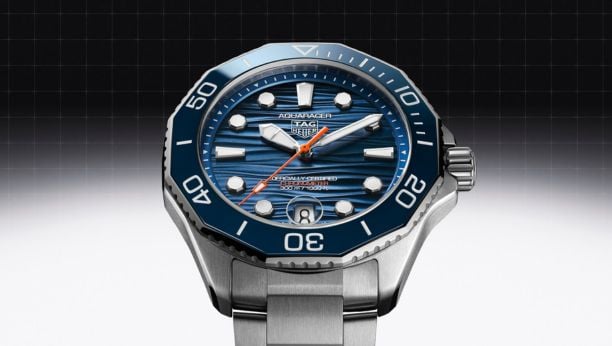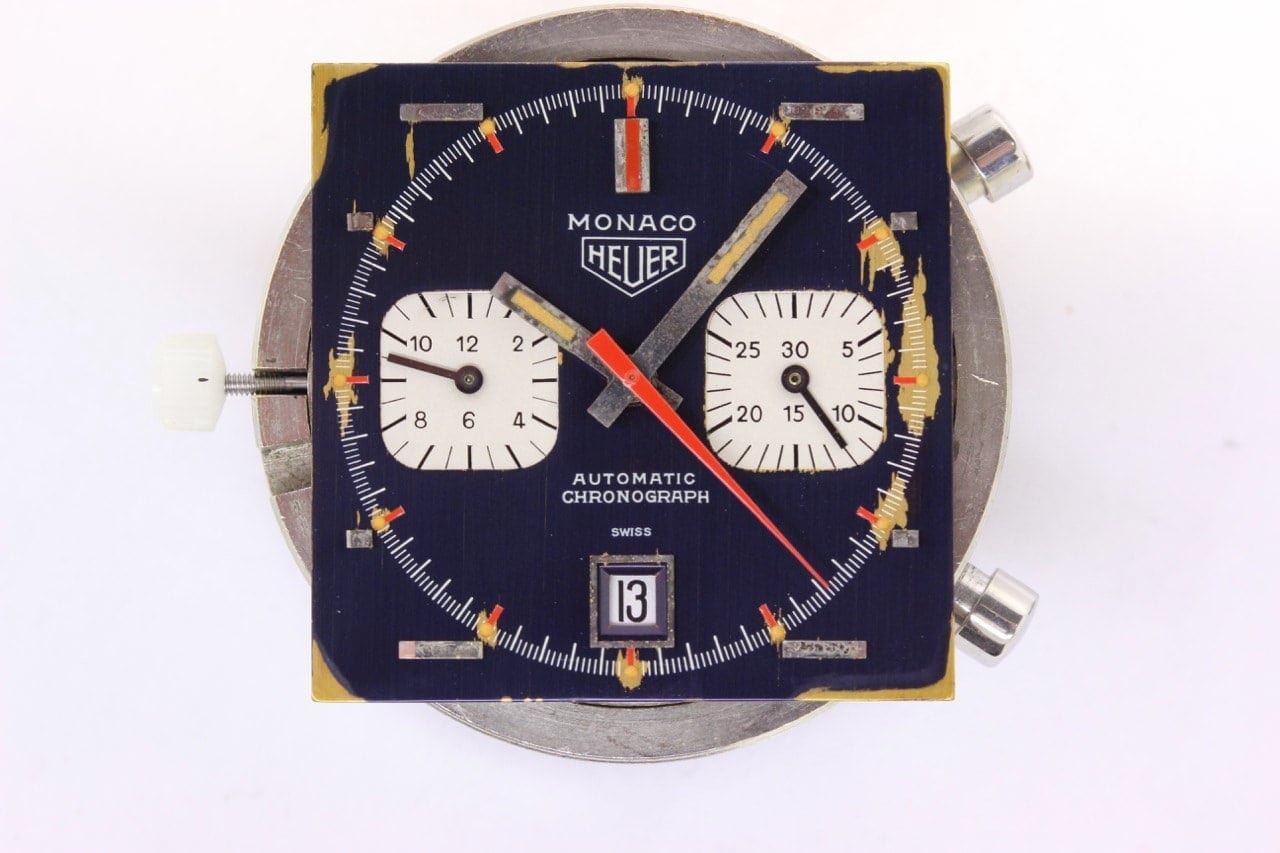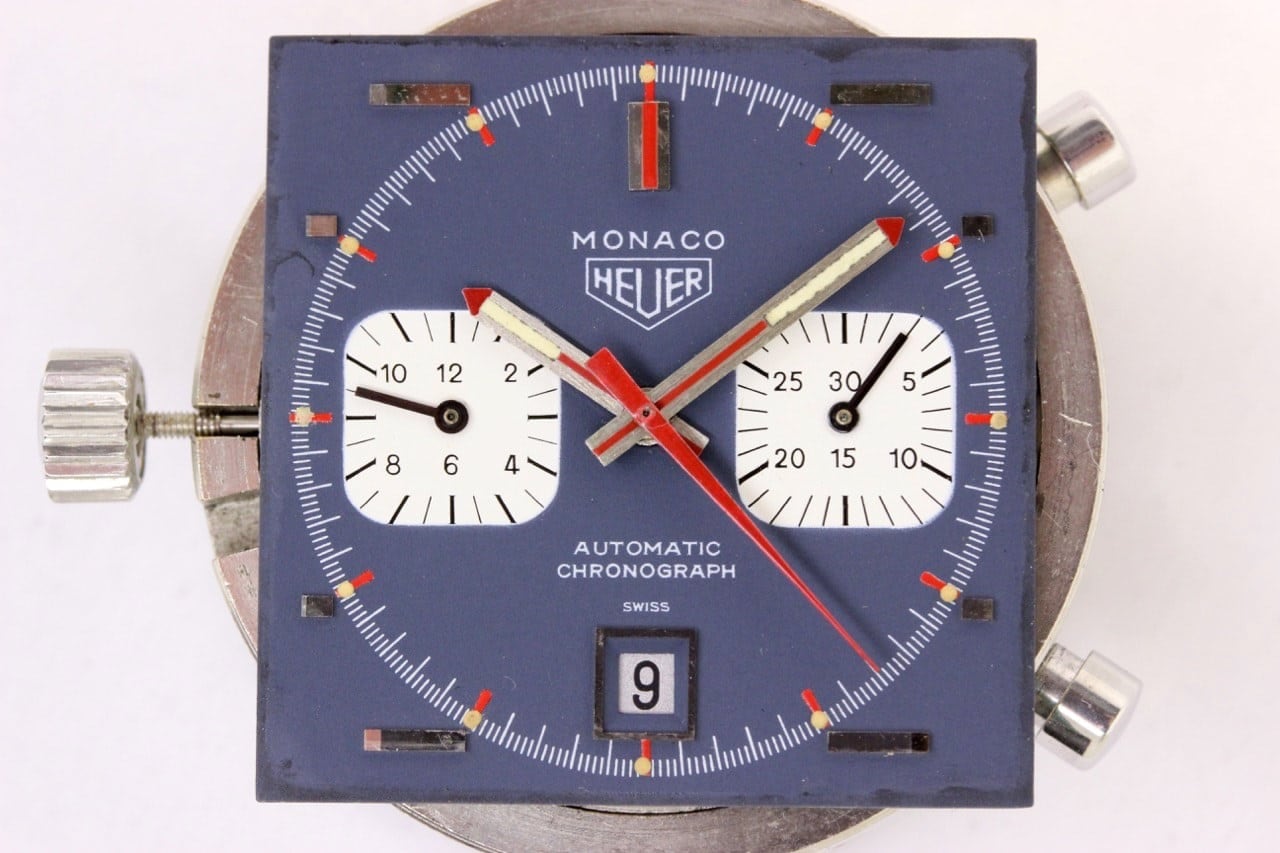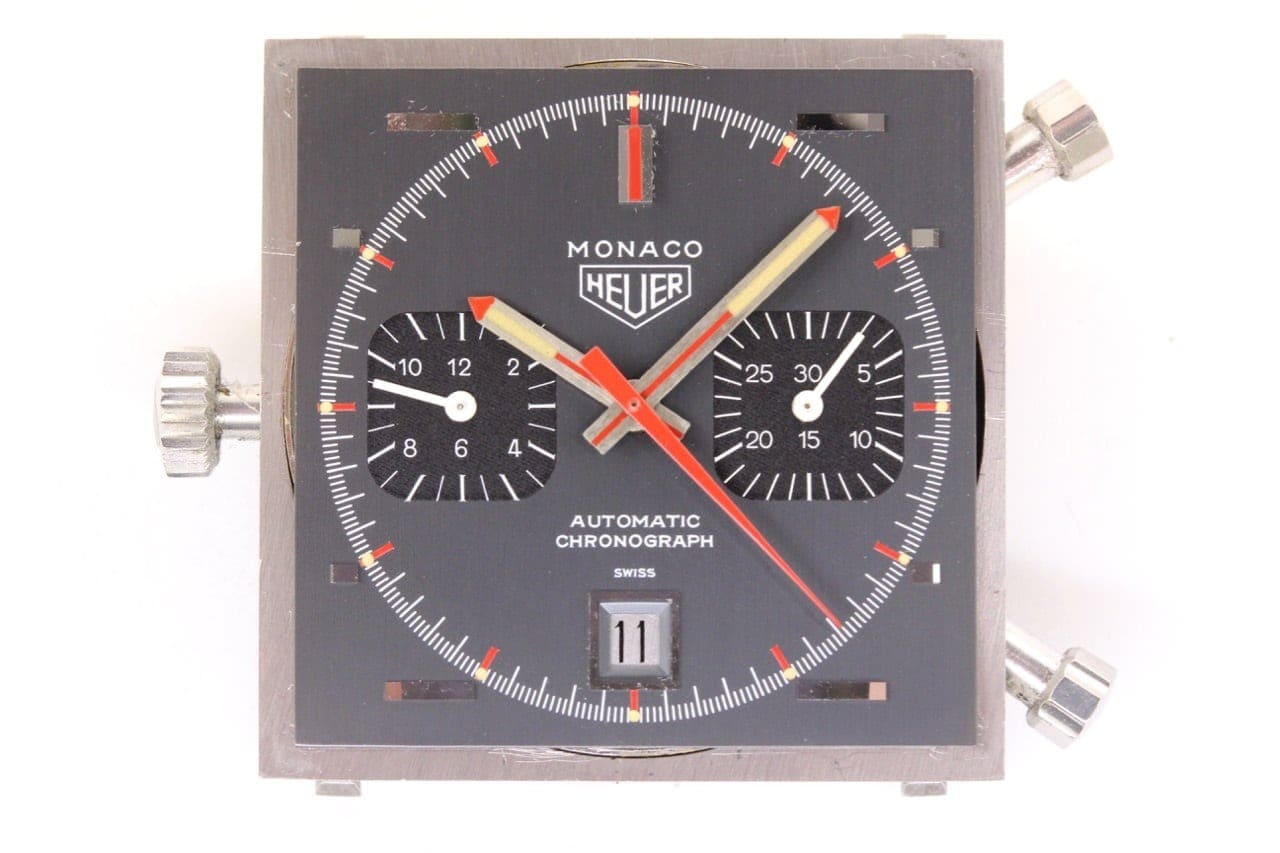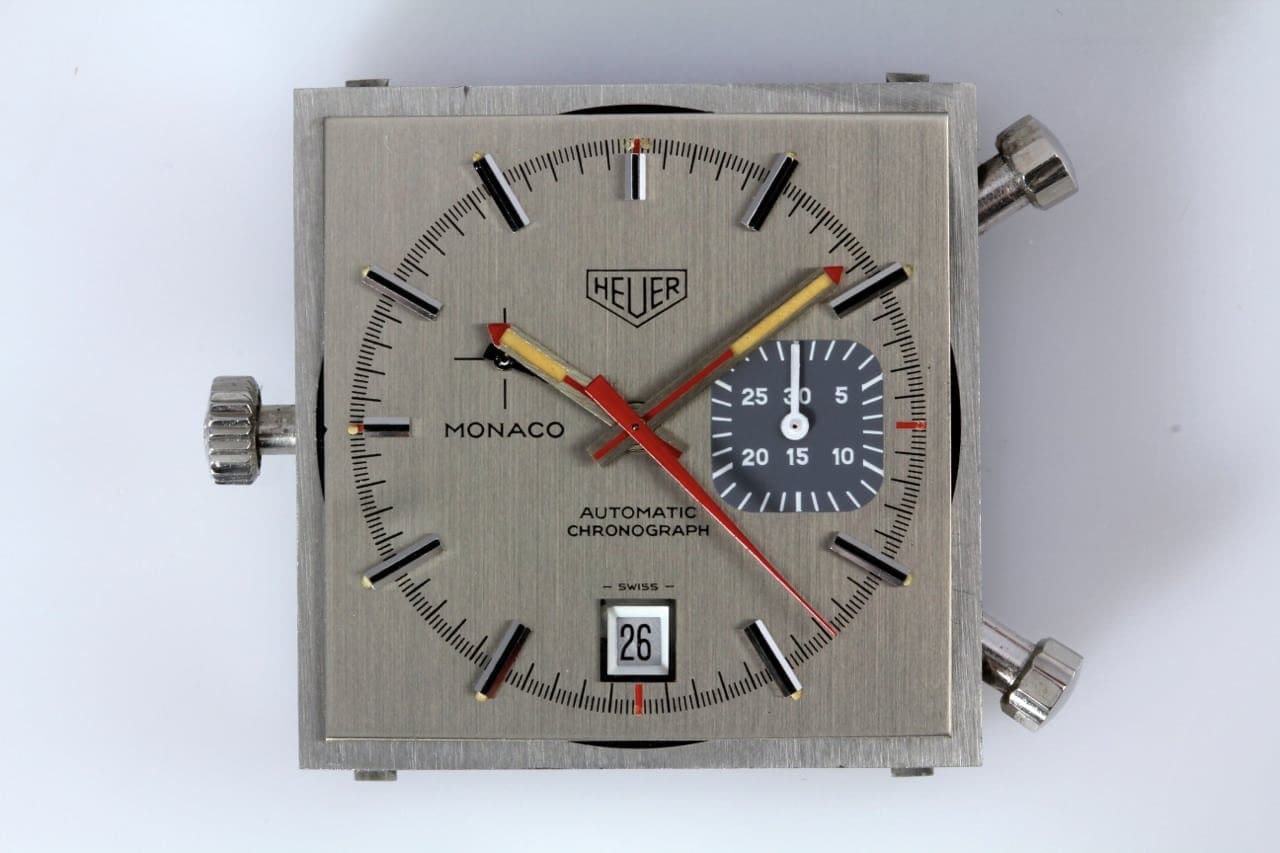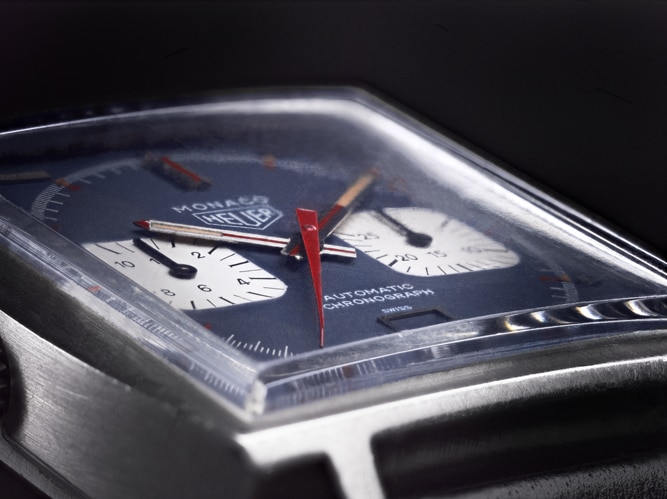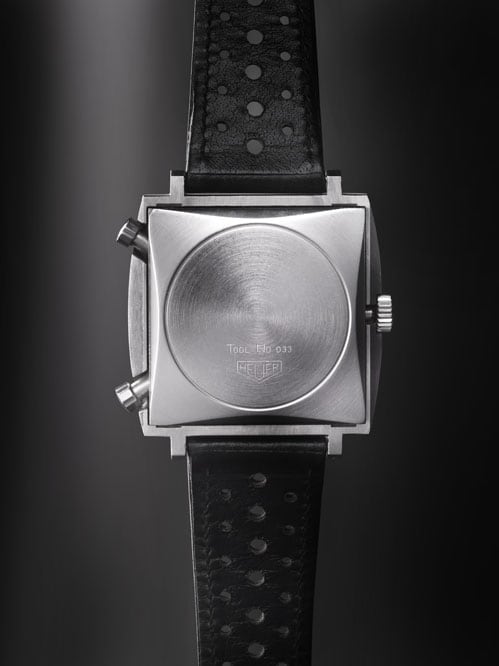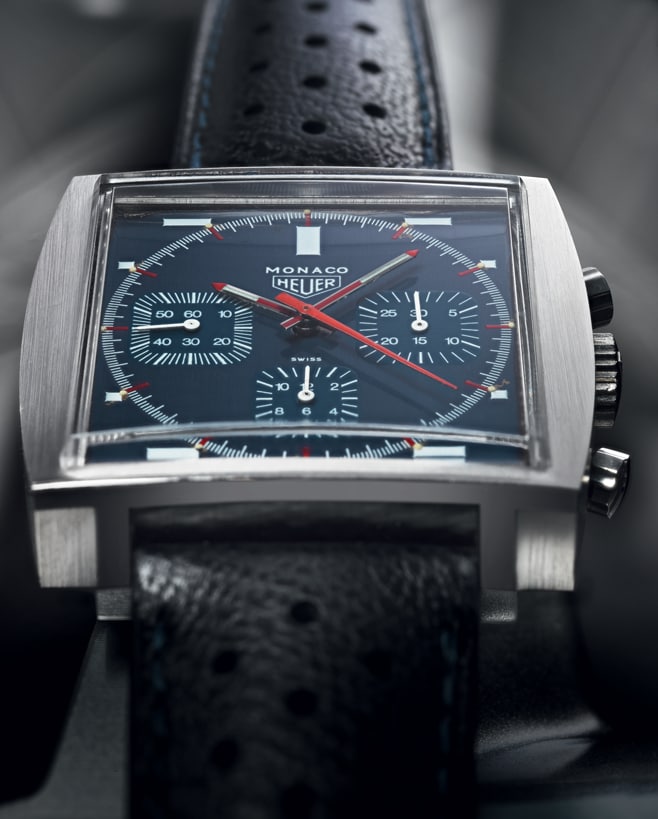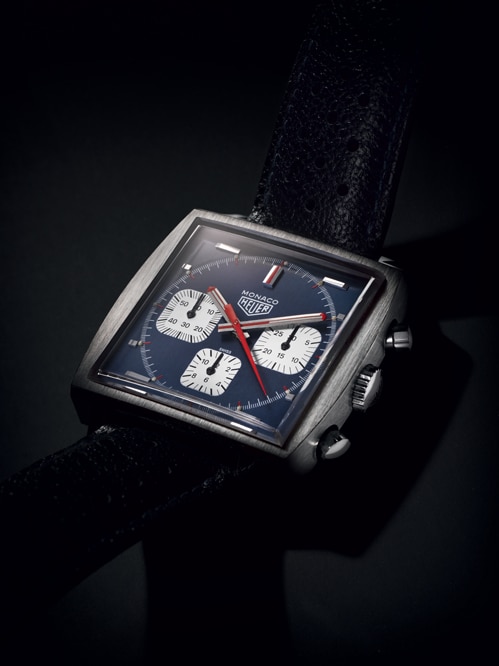vintage collection
VINTAGE HEUER MONACO
When Heuer introduced its first automatic chronographs in 1969, the Autavia and Carrera moved to new cases to accommodate the larger Chronomatic Calibre 11 movement, while the Monaco was an entirely new model, its radical shape and colors designed to showcase the new movement that would take Heuer into the 1970s. Ironically, the Autavia and Carrera would survive the decade that was so challenging for the Swiss watch industry, while the Monaco would be discontinued around 1975. Since TAG Heuer created the first re-edition of the Monaco in 1997, however, the Monaco has been produced in a wide variety of styles, colors, configurations and materials, some following the lines of the very first models from the 1970s and others taking the Monaco collection even further beyond conventional watch design. Yes, the Monaco was ahead of its time in 1969, but the last 25 years have established that the “circle in the square” is the timeless design it was expected to be.
In the mid-1960s, as Heuer was hard at work on the project to develop the world’s first line of automatic chronographs (under the code name “Project 99”), the company faced the question of which models would use the new movement (eventually called the Calibre 11 movement). Dating from 1962 and 1963, the Autavia and the Carrera seemed like appropriate models to fly the new flag. As Jack Heuer reflected in an interview:
“So we decided to make a Carrera, because the Carrera was already a very good model in non-automatic. We made it in self-winding, but this movement [Calibre 11] was quite a bit thicker, so we had to change the shape a little bit. And then we decided that we need something for our Automotive-Aviation market, so we made the Autavia. ”
The choice of the Autavia and the Carrera made good sense. With its rotating bezel and relatively large size, the Autavia was a tool watch for racing and aviation, and upsizing the case seemed consistent with the style of the watch. The Carrera used a traditional round case and was favored by the dynamic individuals who might have wanted something a bit more elegant, and its style could also be continued in a larger case. Indeed, both these models could be “upsized”, so that the case would accommodate the larger Calibre 11 movement.
Heuer anticipated, however, that the new automatic chronographs would be a sensation, and to fully leverage the effort and expense of creating the new movement, it would be prudent to add a third model to the line-up. With the Autavia and Carrera both reflecting traditional styles and being well-established in the market, Jack Heuer believed that Heuer could take the chance of creating a third model that would be “out of the box.” As Jack Heuer explained in his autobiography the role of Piquerez in developing the Monaco:
“One day, a representative of one of our most reliable watch case suppliers, a company called Piquerez, located at Bassecourt in the Jura, came to us on one of his regular visits to show us Piquerez’s latest samples of watch cases in mock-up form. He drew our attention in particular to a new patented square case Piquerez had developed, emphasising the fact that it was fully water-resistant. We immediately knew this was something special because until then square cases were used only for dress watches because it was impossible to make a square case fully water-resistant. At Heuer a decision had been taken around 1941 to produce only water-resistant chronographs because any water penetrating a chronograph’s case and reaching the movement causes serious damage that is very costly to repair.
We immediately took a liking to the special square shape and were able to negotiate a deal with Piquerez that secured us exclusive use of the case design for chronographs. This way we could be sure that Breitling would not produce a chronograph housed in a similar case when we all unveiled our new products using the revolutionary Calibre 11 microrotor-based self-winding mechanism that was at the heart of Project 99. The revolutionary square case would be the perfect housing for our avant-garde “Monaco” wrist chronograph.”
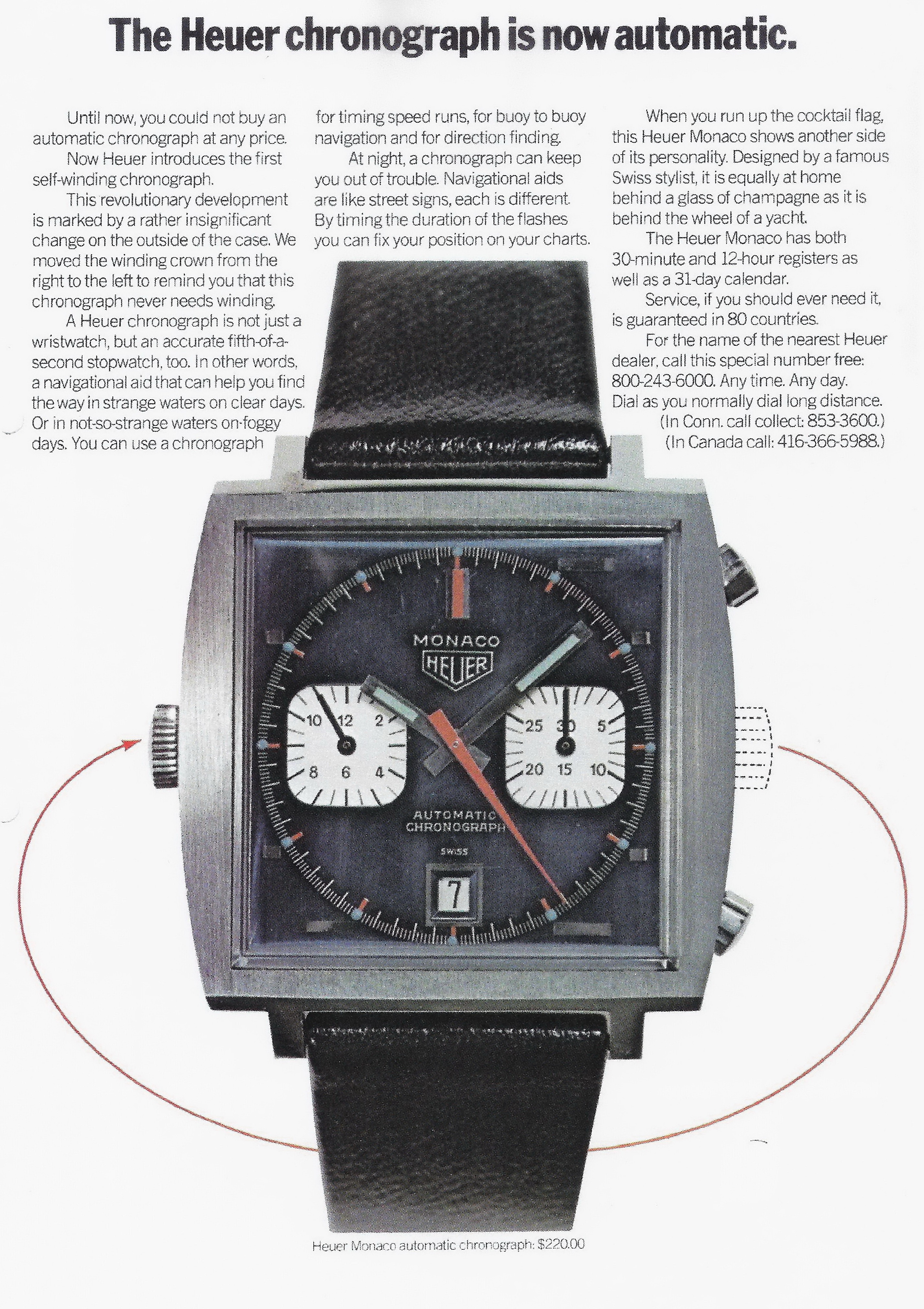
These stories of how the Monaco came to be explain why Heuer took such a risk with the shape of the watch, because much like a concept car highlighting a new engine, the radical shape was chosen to draw attention to the newness of the movement (and also to the companion Autavia and Carrera models). It was a statement watch designed for the avant-garde – not the conventional mainstream.
And our review of its history, both in the 1970s and in the current century, will demonstrate that if the Monaco chronograph was, in fact, ahead of its time in 1969, it has recently taken its rightful place as a timeless classic, consistent with Jack Heuer’s objective of building a watch for those who enjoy avant-garde styles.
MONACO DESIGN
The Monaco is a unique chronograph, an iconic piece of late 1960s design that is instantly recognizable.
CASE
The Monaco has a relatively simple two-piece case, with the top section, sometimes called the bezel, being held to the back by a sprung pins. All vintage versions of the Monaco have the same basic case - it’s stainless steel, measuring 39 millimeters across and 22 millimeters between the lugs. The sides of the case are rounded to give a convex rather than straight-edged shape, and the edges of the case and lugs are sharp.
The finishing on the case is one of the model’s hallmarks, a unique combination of brushed and polished surfaces on the front of the case. The case-back has a polished center, marked with the Heuer shield and the number of the tool used to open the case (Tool No. 033), with a sun burst brushed finish between the center and the edges.
As on all Heuer chronographs of the period, the model reference number is engraved between one set of lugs, while the serial number is engraved between the other lugs.
DIALS
In simplest terms, there are two dial colors for standard production Monacos -- midnight blue and charcoal grey. Upon closer inspection, however, we see a variety of shades within the blue and gray ranges (for example, the early blue models have a deep, metallic finish, while later blue models are a paler shade, and the Calibre 15 model (described below) has a different shade again.
The gray dials show a similar variety of shades, with grained finishes, flat greys and darker shades that can almost look black. The gray Calibre 15 model is entirely different from all other gray models, being a golden silver colour with a beautiful brushed finish.
Over the years, we have seen that the deep blue paints used on watch dials in the late 1960s, proved to have issues of durability. While the paint will remain entirely intact on some watches, we also see samples that have lost all their blue pigment (so that the dial is now the color of the underlying brass material) and other samples that suffer paint loss in limited areas of the dial (typically, adjacent to the applied markers).
The Monaco dials- whether they be two or three registers - all have a printed circular minute scale that provides a wonderful contrast to the blunt edges of the square case.
The most unusual register layout is on the Calibre 15 models, which have a single chronograph minute register at 3 o’clock and a smaller runnigs seconds hand at around 9.30 on the dial, with a cross-hair marking. These are also the only vintage Monaco chronographs to have their hour-markers positioned radially (a style that has been incorporated into many of the re-editions produced by TAG Heuer).
STEVE MCQUEEN AND THE HEUER MONACO
Well before the era of “Actor Ambassadors”, Steve McQueen wore a Heuer Monaco in the movie Le Mans, providing a series of iconic images, that still today form a central part of TAG Heuer’s marketing campaigns. But just how did McQueen come to strap a Monaco to his wrist? Again we turn to Jack Heuer for the story:
“I had recruited Don Nunley, a property master in Hollywood, to help me with my early efforts at product placement in Hollywood films. In early June 1970 he called me from Hollywood and said: “Jack, I have some good news for you. I have been appointed property master on the film ‘Le Mans’ which will star Steve McQueen as a racing driver. But now I need much more than a few chronographs. I need stopwatches, timing boards, large pocket chronographs and any other timing paraphernalia you can think of that’s used in motor racing. But I need to have all this within the next ten days as we start shooting at Le Mans in a week or two.
On hearing the name of the King of Cool connected with stopwatches my ears went up like flick knives and I immediately sprang into action to get all this equipment ready and crated for shipping to France. However, since these watches and timing devices had not technically been sold it would have taken me too long to get the export papers required for what would in effect be just a “temporary import”. I instructed our driver simply not to declare them at the border when crossing into France. The driver, Gerd-Rüdiger Lang, had asked to work for us to improve his knowledge of watchmaking in general and chronographs in particular. He was a very nice and talented person and I was planning to send him to our US subsidiary on a temporary US visa. This had turned out to be impossible, since in our case these special US visas were issued only to Swiss citizens and Gerd-Rüdiger was German.
Anyhow, I gave Gerd-Rüdiger cash for his travelling expenses and he set off for Le Mans in his own car loaded with our equipment. He was of course stopped at the French border and had to hand over most of his travelling expenses to pay customs duty and a fine. But he arrived safely on time on the film set in Le Mans and delivered all the props to Don Nunley. He also got to meet Steve McQueen and returned safely to Bienne.
About 10 days later I received another phone-call from Don Nunley who said: “Jack, this time I’ve even better news for you. We’ve finished the trial shots and will start shooting for real tomorrow. Steve McQueen is going to wear one of your “Monaco” wrist chronographs and will also wear the Heuer logo on his overalls. But I have a problem: what shall I do with the watches when shooting is over in about three weeks’ time?“ Delighted with this good news, I thought for a moment and had nightmare visions of the customs hassle if we attempted to bring back the watches we had “smuggled” into France. I told Don he could give the watches away as gifts.
As I was not present at the moment when Steve McQueen chose to wear a Heuer “Monaco”, I have to draw on hearsay from Don Nunley and Derek Bell, the British racing driver who also took part in the filming. The film company had hired two professional racing car drivers to coach McQueen to drive the unbelievably-fast Porsche 917. One was Derek Bell and the other was Jo Siffert, who was under contract with us. McQueen and Siffert got on like a house on fire, perhaps because they had both started their lives in humble circumstances and had gone on to become superstars in their respective professions. The day before shooting was due to start, one of the film’s production executives, Robert Rosen, went up to Steve McQueen and said: “Steve, tomorrow we start shooting for real. So far you’ve worn several types of racing overalls but now you’ve got to settle on how you want to look.” Apparently McQueen pointed towards Jo Siffert and said he wanted to look exactly like him. Siffert then ran to his caravan to fetch one of his white racing overalls which had the Heuer logo on the heart side and handed it to McQueen.
Then Don Nunley went up to McQueen and said: “Now you have to choose a watch – here’s a nice Omega!” Apparently McQueen then handed the Omega back to Nunley, saying: “Not an Omega, they might use my name”, and instead he chose a Heuer “Monaco”, never having heard of us. Don Nunley says he had to offer the “Monaco” because it was the only watch of which he had three identical models. He needed three because one model would be used in the live racing shots, one would be used in the still photography and one was needed as a spare in case the others got damaged. Furthermore, if Jo Siffert’s racing overalls were emblazoned with a Heuer logo, film continuity demanded that the driver should also sport a Heuer chronograph on his wrist!”
The specific model that McQueen wore in Le Mans was the reference 1133B Monaco, and some of the watches used by McQueen in the filming are now on display in the TAG Heuer Museum.

THE VINTAGE MONACO RANGE
There are four district references in the vintage Heuer Monaco series -- two types of automatic chronographs and two types of manual-wind chronographs.
- Reference 1133 -- Calibre 11/12 automatic movement with blue or grey dial (1969 to 1975)
- Reference 1533 -- Calibre 15 automatic movement with blue or grey dial (1972 to 1975)
- Reference 73663 -- Valjoux 7736 manual movement with blue or grey dial (1972 to 1975)
- Reference 74033 -- Valjoux 7740 manual movement with blue or grey dial (and limited production with black dial) (1974 to 1975, and 1977 for black dial)

REFERENCE 1133B - CHRONOMATIC & TRANSITIONAL
The very first batch of Monacos in 1969 had a metallic blue dial with light blue/green lume on the dial pips and the hands. These early samples are easy to spot with their square-ended steel hour and minute hands, and the legendary “Chronomatic” script above the Heuer logo and the “Monaco” printed across the bottom of the dial.
The Chronomatic version of the Monaco was produced for a very short time (and in limited quantities). Jack Heuer has explained that, particularly in the United States, customers and sales personnel in retail store did not realize that “Chronomatic” meant “Automatic Chronograph, so Heuer soon decided to abandon the “Chronomatic” name and print “Automatic Chronograph” across the bottom of the dial.
The first watches after the move away from the “Chronomatic” name have the same style of paint and hands, and are known as the “Transitional” version, as they are the model that transitions the look of the Monaco from the “Chronomatic” blue to the standard “production” Reference 1133B, as worn by Steve McQueen.
REFERENCE 1133B - STANDARD PRODUCTION VERSION
The standard “production” version of the Monaco chronograph, as worn by Steve McQueen in the movie Le Mans, had the highest production of any of the vintage Monaco chronographs. The paint is a flat (non-metallic) midnight blue and the registers are bright white. Hands of the “McQueen” Monaco have a brushed metallic finish, with luminous and red inserts and red triangular tips. These hands are seen on the majority of vintage Monacos with a small batch should hands that are half red, and the very first (Chronomatic and Transitional) with their distinctive rectangular hands and last (black-coated) reference 74033N.

There was no “Chronomatic” version with a gray dial, but two standard production models (Reference 1133G). The first execution had a metallic gray dial, with matching registers, and the second execution had a metallic gray dial, with contrasting black registers.
REFERENCE 1533 - CALIBRE 15
In 1972, Heuer introduced the Calibre 15 movement, in an effort to reduce the cost of the previous Caliber 12 chronographs. Offered across the Monaco, Autavia and Carrera ranges, alongside the Calibre 12 variants, the Calibre 15 movement deleted the hour recorder and used a less expensive shock-proofing system.
The Calibre 15 chronographs have a 30-minute chronograph register at 3 o’clock and running seconds at 9:30 on the dial.
Heuer took the revised movement layout as an opportunity to offer a totally new look for the Calibre 15 Monaco chronographs.

The Reference 1533B Monaco has a midnight blue dial, with its applied hour markers positioned radially. The chronograph minutes register at 3 o’clock ranges in color from a white to a blue-grey.
REFERENCE 1533G GREY DIAL
The Reference 1533 G Monaco has a metallic gray dial, that is unique to this version of the Monaco, with the chronograph minutes painted a dark blue / gray.
REFERENCE 73633- VALJOUX 7736
In a further effort to make the Monaco more accessible, a manual wind version was introduced powered by the Valjoux calibre 7736.
REFERENCE 73633B BLUE DIAL
The Reference 73633 B incorporates a color scheme that is identical to the standard production automatic “McQueen” Monaco, with a third register for running seconds positioned at 9 o’clock.

The reference 73663 G three-register Monaco was produced in two executions, which parallel the reference 1133 G automatic models. The first execution had a metallic gray dial, with matching registers, and the second execution had a metallic gray dial, with contrasting black registers.
REFERENCE 74033- VALJOUX 7740
The reference 74033 Monacos use the same two-register / date arrangement as the reference 1133 automatic models, with the deletion of the “Automatic Chronograph” printed on the dial, as it is now powered by a manual wind movement, and the crown moving to the right-hand side of the case.
REFERENCE 74033B BLUE DIAL AND 74033G GRAY DIAL
The reference 74033 B uses the same colors as the automatic “McQueen” Monaco (reference 1133B), while the reference 74033 G matches the colors of the first execution automatic gray Monaco (reference 1133G).
THE REFERENCE 74033N (BLACK-COATED CASE)
Heuer stopped production of the Monaco chronographs circa 1975, but as black-coated chronographs became more popular over the course of the decade, the company produced one additional version of the Monaco, using a black-coated case and a distinctive black dial (the reference 74033 N). The three chronograph hands (for hours, minutes and seconds) were painted a bright orange, while the hour markers on the dial were simple luminous strips. Bright white hands completed the very dramatic look of this very last version of the Monaco.
This version of the Monaco never appeared in a Heuer catalog, and its production and distribution history remains a mystery. When questioned about the watch, Jack Heuer suggested:
“I don’t really remember- you see, the military black became the fashion in the late 1970s and we were some of the early users of military black- it didn’t cost that much to take your existing case and have the coating added, so we had to enlarge the collection as maybe someone would buy some more of the Monaco, but I don’t remember when we did it….maybe we said let’s make 100 pieces to try it.”
The consensus among today’s collectors is that the reference 74033 black-coated Monaco was produced by Heuer in relatively small quantities, with distribution limited to markets where the company believed that the “tactical” look of the watch would meet with success. The watch never appeared in any Heuer catalog or advertising.



